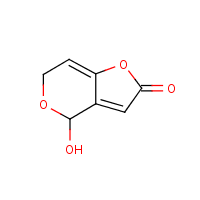Patulin
Agent Name
Patulin
CAS Number
149-29-1
Formula
C7-H6-O4
Major Category
Biological Agents

Synonyms
(2,4-Dihydroxy-2H-pyran-3(6H)-ylidene)acetic acid, 3,4-lactone; (2,4-Dihydroxy-2H-pyran-3(6H)-ylidene)acetic acid-3,4-lactone; 2,4-Dihydroxy-2H-pyran-delta-3(6H),alpha-acetic acid-3,4-lactone; 2H-Pyran-delta(sup 3(6H),alpha)-acetic acid, 2,4-dihydroxy-, 3,4-lactone; 4-Hydroxy-4H-furo(3,2-c)pyran-2(6H)-one; 4-Hydroxy-4H-furo(3,2-c)pyran-2(6H)-one; 4,6-Dihydro-4-hydroxy-2H-furo(3,2-c)pyran-2-one; Acetic acid, (2,4-dihydroxy-2H-pyran-3(6H)-ylidene)-, 3,4-lactone; Clairformin; Clavacin; Clavatin; Claviform; Claviformin; Expansin; Expansine; Gigantin; Leucopin; Mycoin; Mycoin C; Mycoin C3; Mycoine C3; Mycosin; Patuline; Penatin; Penicidin; Tercinin; Terinin; [ChemIDplus] UN3462
Category
Mycotoxins
Description
Solid; [Merck Index] Colorless or white odorless solid; [HSDB] White crystalline solid; [Aldrich MSDS]
Sources/Uses
Mycotoxin metabolite of many molds that possesses antibacterial, antiviral, and antiprotozoal properties but is toxic to plants and animals; One of the most common sources of contamination is from the blue mold (Penicillium expansum) that causes soft rot of apples, cherries, and other fruit; Also found often in unfermented apple juice; [Reference #1] Antibiotic metabolites derived from various fungi in the Aspergillus, Penicillium, and Gymnoascus species; [Merck Index] Mycotoxin produced by Aspergillus and Penicillium species found in unfermented apple juice and grape juice and field crops; [ChemIDplus] Mycotoxin found on fruits, vegetables, grains, and other foods; Also produced by the fungi Byssochlamys nivea; Purified form included in analytical reagent kit used as a standard for mycotoxins; Formerly used as a topical antibiotic cream; [HSDB]
Comments
No direct or conclusive evidence for natural poisoning, although has been shown to be toxic at high concentrations in the laboratory; [Reference #1] Causes irritation when applied dermally to humans; Oral administration in humans causes stomach irritation, nausea, and vomiting; [HSDB] The major sources of dietary exposure are from apples and apple juice made from contaminated fruit; A provisional maximum tolerated daily intake (PMTDI) of 0.0004 mg/kg was set in 1995; [JECFA] Toxic to liver in oral lethal-dose studies of mice; [RTECS] An irritant; Fatal by ingestion; [Aldrich MSDS]
Reference Link #1
Biomedical References
Exposure Assessment
Vapor Pressure
6.8E-06 mm Hg
Explanatory Notes
The Guide in the Emergency Response Guidebook is for "Toxins, extracted from living sources, solid, n.o.s."
Adverse Effects
Hepatotoxin
Hepatoxic (a) from occupational exposure (secondary effect) or (b) in animal studies or in humans after ingestion
IARC Carcinogen
Not classifiable
Diseases, Processes, and Activities Linked to This Agent
Other Information
No other related information on this agent was found.